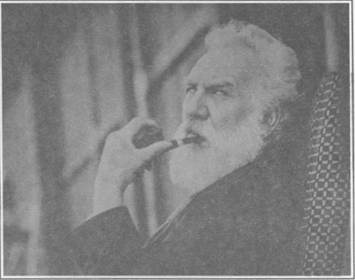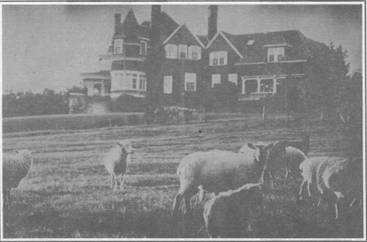
|
Bell at Beinn Breagh
For years, many people were leaving Newfoundland to visit the North American continent but ended up staying permanently in Cape Breton. Here is a story of someone who did it the other way. He was heading for Newfoundland but he ended up staying in Cape Breton.
Alexander Graham Bell was on vacation and was heading for Newfoundland with his family. His in-laws, the Hubbards, had invested a lot in the Caledonia Coal Mines Society in Cape Breton, so Alexander wanted to see where they had invested their money. He had read a book about Baddeck so he decided to stop there during the trip. For Bell, it was an opportunity to visit the area.
Bell had lived in Canada and in the U.S. and had become a U.S. citizen but his heart was still Scottish. He spoke with a Scottish accent and the hills of Cape Breton reminded him of the time when he walked as a child through the hills of Scotland.
Beinn Breagh
They were so pleased with the area that they cut short the Newfoundland trip by staying in Baddeck. At first, they stayed in the Telegraph House Inn but as the trips became regular summer sojourns, the Bells bought a property at Red Head across the bay from the town. He named the site Beinn Breagh (celtic for "beautiful mountain") and eventually acquired 600 acres.
Beinn Breagh became his escape from the oppressive summer heat and the social demands placed upon him at home in Washington. It was a place to think, to try new things, to indulge himself in what interested him. These interests ranged from the development of a hydrofoil which held the world's speed record for many years, to the application of genetic studies in the raising of sheep.
Litigation as a result of counter claims to his invention of the telephone took much of his time and energy. This consumed precious time that could otherwise have allowed him, along with J.A.D. McCurdy, Casey B aldwin and Glen Curtiss to bring a plane into the air before the Wright Brothers. They still managed to register the first powered flight by a Canadian in 1908 aboard the Red Wing. This was followed by the White Wing, the June Bug, the Loon and finally the Silver Dart.
Bell was not an inventor of the same mould as Edison, Fessenden or Marconi. These were men driven with a desire to make financial success of their work. Edison claimed that he "invented to make money so that he could invent", Marconi was quick to patent and enforce his inventions and Fessenden ultimately gained financial security from his.
Possibly because of the financial security he had gained from the telephone and aided by thè fact that the Hubbards were wealthy, Bell could take the time to blaze new trails. He once said: "We should not keep forever on the public road, going only where others have gone; we should leave the beaten track occasionally and enter the woods."
He did not always "enter the woods". He made improvements to Edison's phonograph calling it the "graphophone" (gramophone). Edison did not appreciate it and said that all he did was turn the name around! His hydrofoil was not new nor were experiments in powered flight but he did "enter the woods" with the "photophone", a forerunner of the photoelectric cell. His experiments with the "tetrahedral" kite were successful enough to lift a man nine meters into the air. His innovations included a laminated wood propeller, triangular ailerons and the use of "dope" to reduce air resistance on the wings.
Bell also hypothesized that sound could be used to locate and avoid icebergs, anticipating "sonar". He invented a surgical probe for locating bullets in a body which was used fairly successfully until the development of X-rays technology. He built a vacuum jacket years before the invention of the iron lung.
Perhaps the greatest legacy for Canadians were the Bell shops setup in 1892 and managed by an ex foreman from the Williams shops in Boston. These Bell shops became Northern Electric and ultimately Northern Telecom, a world class supplier of telecommunications.
A legacy to Cape Breton
Baddeck remains a sleepy village on the Bras D'Or Lake. The Telegraph House Inn remains, still owned by the Dunlops, the same family that bought it in the 1850's and rented rooms to the Bell entourage each summer. You can still sleep in the small room Bell occupied at the front of the inn overlooking Main Street and the lake, where Bell's hydrofoil sliced through the calm waters, where on a cold February day, the Silver Dart rose into the air and into history.
Beinn Breagh still overlooks the town and is still owned and occupied periodically by the Bell heirs, surrounded by the green hills that feed Bells sheep andwhere a gentle, white-bearded "Santa Claus" in golfing knickers walked hand in hand with Mabel, his wife.
Alexander Graham Bell and Mabel are buried there in a simple grave on the hill overlooking the bay where for a time Canada made world history.
In the town is housed the Bell National Historic Site, a museum containing original artifacts and copies of all the Bell papers. One room contains the remnant of the original hydrofoil and a reconstructed one. The collection fills the site with models and actual prototypes are on display, complemented with films, slides and video displays.
Efforts are underway to expand and improve the site into a world class centre housing such items as a replica of the Silver Dart. Better facilities for the handicapped are required. A workshop and teaching area must be developed, more interactive exhibits must be designed, additional artifacts must be housed and shown.
Jack Stephens, Superintendent of the site, received Minister Masse last summer, and continues to communicate with our regional office staff in Moncton.
|
||








